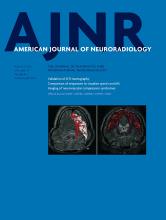Index by author
Parker, D.L.
- Extracranial VascularYou have accessPrediction of Carotid Intraplaque Hemorrhage Using Adventitial Calcification and Plaque Thickness on CTAL.B. Eisenmenger, B.W. Aldred, S.-E. Kim, G.J. Stoddard, A. de Havenon, G.S. Treiman, D.L. Parker and J.S. McNallyAmerican Journal of Neuroradiology August 2016, 37 (8) 1496-1503; DOI: https://doi.org/10.3174/ajnr.A4765
Parvathaneni, U.
- Head and Neck ImagingYou have accessDo Radiologists Report the TNM Staging in Radiology Reports for Head and Neck Cancers? A National Survey StudyB. Ko, U. Parvathaneni, P.A. Hudgins and Y. AnzaiAmerican Journal of Neuroradiology August 2016, 37 (8) 1504-1509; DOI: https://doi.org/10.3174/ajnr.A4742
Pope, W.B.
- EDITOR'S CHOICEAdult BrainOpen AccessImproved Leakage Correction for Single-Echo Dynamic Susceptibility Contrast Perfusion MRI Estimates of Relative Cerebral Blood Volume in High-Grade Gliomas by Accounting for Bidirectional Contrast Agent ExchangeK. Leu, J.L. Boxerman, T.F. Cloughesy, A. Lai, P.L. Nghiemphu, L.M. Liau, W.B. Pope and B.M. EllingsonAmerican Journal of Neuroradiology August 2016, 37 (8) 1440-1446; DOI: https://doi.org/10.3174/ajnr.A4759
The authors' hypothesis is that incorporating bidirectional contrast agent transport into the DSC MR imaging signal model will improve rCBV estimates in brain tumors. A unidirectional contrast agent extravasation model (Boxerman-Weisskoff) was compared with a bidirectional contrast agent exchange model. For both models, they compared the goodness of fit with the parent leakage-contaminated relaxation rate curves and the difference between modeled interstitial relaxation rate curves and dynamic contrast-enhanced MR imaging in 21 patients with glioblastoma. The authors conclude that the bidirectional model more accurately corrects for the T1 or T2* enhancement arising from contrast agent extravasation due to blood-brain barrier disruption in high-grade gliomas by incorporating interstitial washout rates into the DSC MR imaging relaxation rate model.








